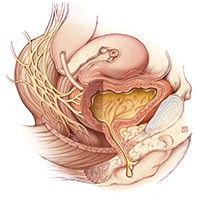Peer Reviewed
Feature Article Urology
Overactive bladder in women: achieving effective management
Abstract
The mainstay of treatment for women diagnosed with overactive bladder (OAB) is lifestyle and behavioural modification (bladder retraining) in combination with medical management such as anticholinergic therapy. Women with refractory OAB should be referred for further investigation and possible treatment with botulinum toxin type A injections or neuromodulation.
Key Points
- Female urinary incontinence is a common problem with an estimated prevalence of 25%. Quality of life is significantly impacted by urinary incontinence, often leading to embarrassment and social isolation.
- Overactive bladder (OAB) denotes a symptom complex of urinary frequency and nocturia associated with urgency, a sudden compelling desire to void that cannot be deferred. It may or may not be associated with incontinence.
- It is important to exclude underlying pathology in women with OAB symptoms, including bladder malignancy, bladder foreign body and voiding dysfunction with overflow incontinence.
- Valuable investigations in a GP setting are a urinary diary, urine microscopy, culture and cytology, and an ultrasound scan of the bladder with postvoid residual volume.
- The mainstay of treatment is lifestyle and behavioural modification in combination with medical management such as anticholinergic therapy.
- Women with refractory OAB should be referred for further investigation with urodynamic studies and cystourethroscopy. Further management of these women includes the use of botulinum toxin type A intravesical injections or neuromodulation.
Picture credit: © Steve Oh.
Purchase the PDF version of this article
Already a subscriber? Login here.

